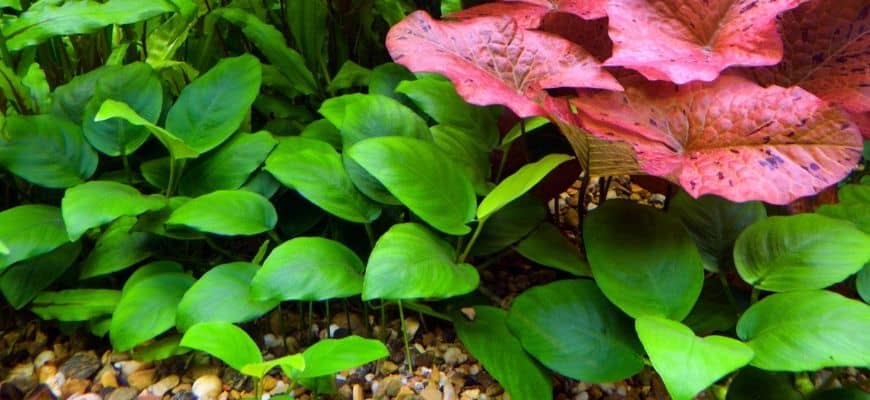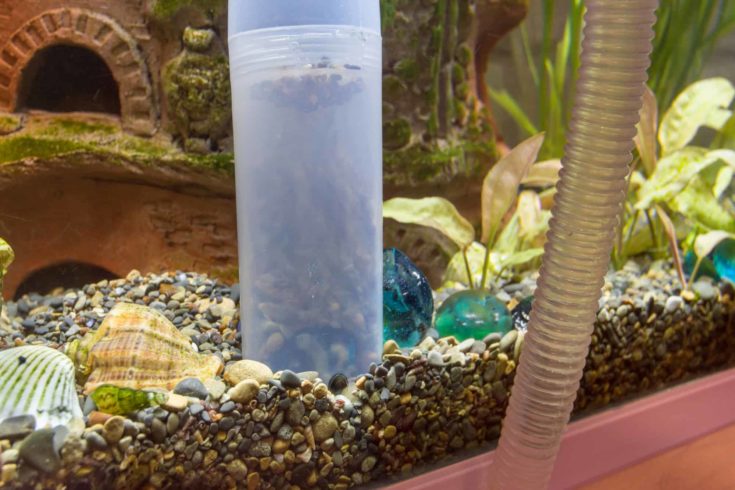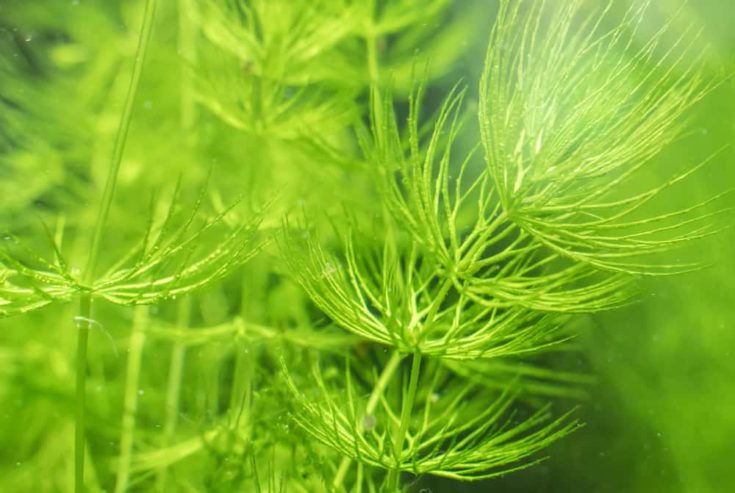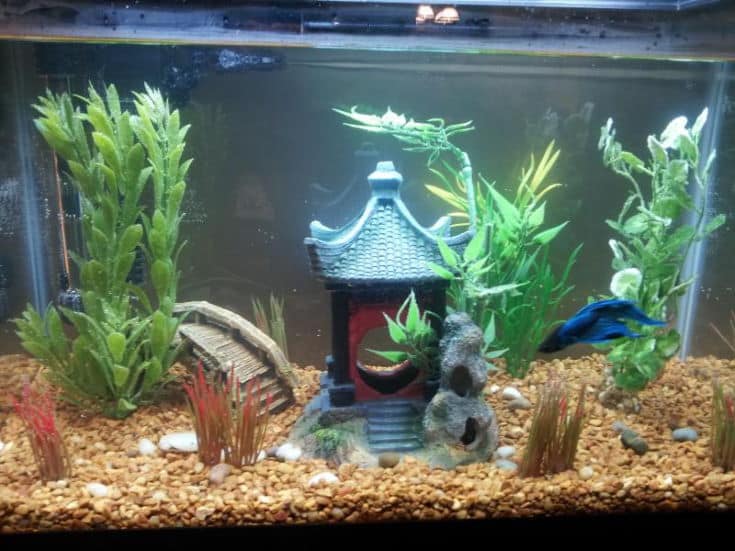In nature, the fishes’ habitat is kept clean and healthy by the rain, natural water flow, and living plants that help to oxygenate the water and absorb nitrates. However, in the closed environment of the home aquarium, you rely on water changes, chemicals, filtration systems, and other artificial agents to keep the environment safe for your livestock.
But wouldn’t it be better if you only needed to perform regular water changes or simple water top-offs? How much easier would the hobbyist’s life be then?
Well, that’s where the Walstad Method comes in.
Keep reading to find out how the Walstad Method could work for your aquarium!
What Is The Walstad Method?

The Walstad Method is named for Diana Walstad, author of the renowned book, “ECOLOGY of the PLANTED AQUARIUM – A Practical Manual and Scientific Treatise for the Home Aquarist.”
Basically, the Walstad Method of freshwater fishkeeping uses organic, additive-free soil as a base layer in the tank, topped with a layer of traditional gravel or sandy substrate.
Living plants are added to the setup, their roots extracting all the nutrients the plants need for growth from the soil and from fish waste. The result is a natural biological filtration system that keeps the water safe and healthy for the fish.
What Do You Need For A Walstad Aquarium?
Although you don’t need lots of fancy equipment to set up a Walstad tank, you will require some basic essentials.
Aquarium
The Walstad Method can be used in any size tank, from a small bowl to a large setup. However, most Walstad aquarists use small tanks from 10 to 40 gallons containing small fish that are less likely to uproot the plants than larger species.
Lighting
One thing that’s essential for the success of the Walstad Method is a full-spectrum LED lighting unit that’s going to provide the light that your plants need for photosynthesis.
Healthy plants are absolutely crucial to this system because they filter toxins from the water, take up carbon dioxide, and produce oxygen.
Plant Soil

The right choice of plant-soil is also crucial for success. Most general terrestrial plant soils will also grow aquatic plants, but not all are suitable.
Lots of potting soils contain additives that can encourage algae growth and alter the water chemistry. Ideally, you want your soil layer with a good balance of inorganic and organic matter but isn’t so rich that it causes an algae explosion. The best choice is organic potting soil, but be sure to check what it contains.
Ideally, you want soil that includes bulk such as sphagnum moss or coconut fiber and organic matter. That mix slowly releases tannins into the water, which helps buffer tap water toward the neutral range, making it suitable for fish and plants. Organic matter, such as bone meal and feather, slowly release nitrogen and calcium into the substrate, where the plants can readily absorb those valuable nutrients.
Substrate
If you’re planning on keeping bottom-dwelling fish that enjoy burrowing and rooting around in the substrate, such as Kuhli loaches, sand is the best choice of substrate. The activity of the fish also helps to aerate the soil, preventing pockets of foul air from forming and encouraging plant roots to spread out and grow.
However, if you prefer, you can use regular aquarium gravel.
Heaters And Filters
Unlike regular aquariums, a mature Walstad tank doesn’t need a filtration system! How so? Well, basically, the substrate and plants form a huge, natural living biological filtration system.
That said, you can add a filter if you have messy fish in your setup and you feel more comfortable doing so. However, don’t use activated carbon, as that extracts organic matter from the water column, which would unbalance the ecosystem you’re trying to create.
Also, a powerful flow rate, airstone, or powerhead will strip carbon dioxide from the water, which the plants need for growth. Although good surface agitation helps to oxygenate the water, which is good news for your fish, the plants that are crucial to the Walstad system need CO2.
Unless you want to keep tropical fish and plants that need warm water, you don’t need a heater.
How To Set Up A Walstad Aquarium
Once you’ve assembled everything you need, you can set up your Walstad tank.
1. Prepare The Aquarium Soil
- Start by sifting your aquarium soil through a colander to remove debris, such as twigs, perlite, and leaf fragments. That stuff has no benefit to your system and simply takes up space or floats around in the water.
- Add a deep layer of the prepared soil to your aquarium. Now, add enough dechlorinated water to wet the soil so that it forms a thick, muddy layer.
- Add a layer of sand or gravel on top of the soil. I recommend using sand, as it’s easier for plants to push their roots through soft sand than gravel. If you’re using gravel, the layer should be 1 to 2 inches thick, whereas you need around 1 inch of sand.
A clay-based substrate looks beautiful and also helps to bind free-floating nutrients to further boost plant growth.
- Now, you can fill the aquarium with dechlorinated water to just below the fill line. That allows for water displacement when you put in your plants and decorations.
2. Choose Your Plants

The right choice of plants is essential for a Walstad aquarium to work properly.
Basically, you need to avoid plants that have very high lighting demands, such as carpeting plants. Diana Walstad recommends using robust root feeders that need low to moderate light to thrive. Floating plants are perfect for a Walstad setup since they grow very close to the light source and they can extract unlimited CO2 directly from the air. Also, plant species that have large, flat leaves are a good choice for the same reasons.
Perfect Floating Plants For A Walstad Setup
Some excellent floating plants for a Walstad Method tank, include:
- Hornwort
- Cabomba
- Salvinia
- Water Lettuce
- Duckweed
- Banana plant
Floating plants help to control algae, as they create shade and rob algae of nutrients. Just ensure that floating plants don’t take over the water surface, cutting out the light from your submerged plants.
Perfect Fast-Growing Plants For A Walstad Tank
Some excellent quick-growing plants for a Walstad Method aquarium include:
- Rooted Hornwort
- Anacharis
- Hygrophila
- Sword plants
- Vallisneria
- Brazillian Pennywort
- Sagittaria
It’s extremely important that you get plenty of rapidly growing plants established in the tank as quickly as possible to kickstart the ecosystem. Once these plants have settled in, you can think about adding other slower-growing species.
Slow-Growing Plants For A Walstad Aquarium
- Anubias
- Cryptocoryne
- Java Fern
- Creeping Jenny
- Mosses
How Many Plants Do I Need For My Walstad Tank?
As your plants act as a natural filter, you want plenty of them!
Ideally, at least 70% of the substrate should be covered by plants, and you also need to include lots of floating species. Basically, the more plants you have in your tank, the more efficient your filtration will be.
Once you’ve chosen your plants, you can add them to your aquarium. Although you ultimately want a thick bed of planting and lots of floating plants, remember to allow plenty of space between the young plants so that they can grow and spread.
Trim off any dead leaves and damaged stems, and follow the planting instructions included with your plants.
Tank Decoration

Diana Walstad advises against including very large pieces of driftwood and rocks in a Walstad tank. Such items can prevent your plants from spreading and can also compact the substrate, preventing the free flow of nutrient-rich water around the plant roots. Also, compacted substrate harbors pockets of bacteria that give off toxic substances, such as hydrogen sulfide, which will kill your fish and plants.
That said, you can use a few small pebbles and pieces of wood to add interest to the aquascape and provide hiding places for fish and invertebrates.
Essentially, you want to create a freestyle aquascape where the plants simply do their thing, entwining around each other, growing and spreading as they would in nature.
How Do I Cycle A Walstad Method Fish Tank?
A regular aquarium must be fully cycled before you can add any fish. Adding fish to an uncycled tank usually ends in disaster, as there’s no established biological filtration system in place to process organic waste. So, levels of toxic ammonia quickly build-up, poisoning the fish within a matter of hours.
The Walstad Method goes completely against the grain by recommending that you add fish to your tank right from the word go! But why?
So, in theory, the soil layer contained in the aquarium is already packed with beneficial bacteria that will happily process any organic waste matter in the water. Hence, cycling the tank in the traditional way is unnecessary. The idea is that the plants act as a filter for the fish and the fish fuel that filter by producing waste.
However, if the plant-soil you’ve chosen is too rich in nutrients, it may leach ammonia into the water, poisoning your fish if you don’t have sufficient plants established. So, before you add any fish to your tank, test the water with an aquarium water testing kit. Ideally, ammonia and nitrites should be zero and nitrates should be below 20ppm.
To be on the safe side, you might need to wait a week or so for the levels to come down before you add any fish.
What Fish Species Are Best For A Walstad Method Aquarium?
Once your Walstad aquarium is set up and the water is safe for fish, you can choose your livestock.
In theory, since you’re recreating a completely natural environment, any fish species should work well in a Walstad tank. However, there are a few important things to bear in mind.
Avoid Diggers!
First of all, I recommend that you avoid choosing large species of confirmed diggers and burrowers that will dig up the plants and disrupt the ecosystem. That includes some species of large cichlids that dig out burrows when spawning.
Plant-eaters, such as goldfish, are also best avoided. That said, if you do want to keep these types, you should use a thick layer of coarse gravel substrate that the fish can’t disturb too much.
Smaller fish that like to root around in the substrate, such as small loaches and dwarf cichlids, should be fine. In fact, these mini excavators can be very helpful, helping to aerate the substrate and feeding on aquatic worms and algae.
Labyrinth Breathers
Also, be aware that labyrinth breathers, such as gouramis and bettas, need ready access to the water surface so that they can breathe atmospheric air. So, if you have lots of floating plants, these fish might not be the best choice.
Recommended Fish For Your Walstad Tank
Pretty much all community fish species do very well in a Walstad aquarium, provided that they share the same temperature, dietary, and water parameter requirements. As with a regular aquarium setup, always do plenty of research when choosing fish to ensure that the species you choose will get along.
All the following community fish species are suitable candidates for life in a Walstad tank, but there are plenty more to choose from, too:
- Bettas
- Gouramis
- Tetras
- Livebearers, including Guppies, Platys, Mollies, Endler’s Livebearers
- Kuhli loaches
- Corydoras catfish
Invertebrates can also make a nice addition to a community Walstad setup, including dwarf crayfish, shrimp, snails, and dwarf crabs.
In Conclusion
I hope you enjoyed our guide to the Walstad Method for planted tanks. If you found the information helpful, please share it!
Maintaining a healthy, thriving aquarium is challenging and time-consuming. But a Walstad tank setup could be a brilliant way of providing a natural, more low-maintenance method of caring for your fish. Choose the suitable growing medium and plants, select fish species that won’t damage the biological filter that the plants create, and check that the tank has cycled properly before adding your fish.
Do you have a Walstad tank? Tell us how the method works for you in the comments box below.